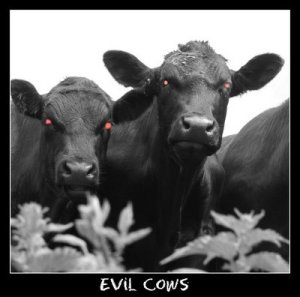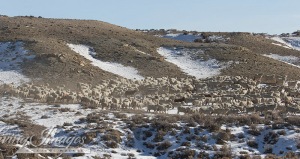Move over Wild Horses, Burros and other native critters as private “welfare” cattle, sheep and goats are coming to destroy the forage on public lands near YOU!!!

Welfare Cattle herded into Antelope Complex as wild horses are being rounded up ~ photo by Terry Fitch of Wild Horse Freedom Federation
News Release WASHINGTON, DC
For immediate release Date: January 30, 2018
BLM and Forest Service announce 2018 grazing fees
WASHINGTON, D.C. – The Federal grazing fee for 2018 will be $1.41 per animal unit month (AUM) for public lands administered by the Bureau of Land Management and $1.41 per head month (HM) for lands managed by the USDA Forest Service.
 The 2017 public land grazing fee was $1.87. An AUM or HM—treated as equivalent measures for fee purposes—is the use of public lands by one cow and her calf, one horse, or five sheep or goats for a month.
The 2017 public land grazing fee was $1.87. An AUM or HM—treated as equivalent measures for fee purposes—is the use of public lands by one cow and her calf, one horse, or five sheep or goats for a month.The newly calculated grazing fee was determined by a congressional formula and takes effect March 1, 2018. The fee will apply to nearly 18,000 grazing permits and leases administered by the BLM and nearly 6,500 permits administered by the Forest Service.
The formula used for calculating the grazing fee was established by Congress in the 1978 Public Rangelands Improvement Act and has remained in use under a 1986 presidential Executive Order. Under that order, the grazing fee cannot fall below $1.35 per AUM/HM, and any increase or decrease cannot exceed 25 percent of the previous year’s level. The annually determined grazing fee is established using a 1966 base value of $1.23 per AUM/HM for livestock grazing on public lands in Western states.

Sheep covering Adobe Town HMA ~ photo by Carol Walker of Wild Horse Freedom Federation
The figure is then calculated according to three factors—current private grazing land lease rates, beef cattle prices, and the cost of livestock production. In effect, the fee rises, falls, or stays the same based on market conditions.
Categories: Horse News, Wild Burros, Wild Horses/Mustangs









Counterpunch
Here’s the Beef: How NAFTA Kissed the West Goodbye
April 15, 2016
As the small ranches go under, their land is either picked up by agribusiness giants like J.R. Simplot or billionaires playing cowboy like David Packard, or subdivided for the dreary ranchettes that disfigure southern Colorado.
The value of the ranch–and hence the approval of the bank or insurance company financing his mortgage–depends entirely on his access to publicly owned grass and water. Even if the rancher wants to reduce the number of cattle he’s running to ease the stress on the grasslands, the BANKS will insist that he continue with the highest stocking rates permitted by the feds, since he will thus be a better risk. This is a primary reason America’s rangelands are in such an impoverished ecological condition.
When the feds have tried to reduce the number of cattle on the public range to protect fragile riparian habitat for endangered trout and salmon, the U.S. government has been sued for breach of contract by the BANKS, notably the FARM CREDIT BANK OF TEXAS, which holds half a BILLION dollars in loans that are tied to FEDERAL GRAZING PERMITS. https://www.counterpunch.org/2016/04/15/heres-the-beef-how-nafta-kissed-the-west-goodbye/
LikeLiked by 2 people
Mortgaging Our Natural Heritage
Taylor Jones and Mark Salvo
The BLM’s Cedar City Field Office in Utah manages grazing permits that ranchers have collateralized for loans worth almost $5 million. The BLM and ranchers maintain high livestock numbers on grazing allotments partly to avoid permittee delinquency on paying these debts. Intensive grazing harms species such as the Utah Prairie Dog, which is listed as “threatened” under the Endangered Species Act.
BLM’s Roswell Field Office manages grazing permits that are collateralized for loans worth over $93 million, more than any other office in New Mexico, and the third most of all BLM field offices in the West. The imperiled Lesser Prairie-Chicken is a victim of these loan agreements.
The BLM Las Cruces Field Office, which manages grazing permits under lien for $48 million, is failing to manage habitat for two important predators in New Mexico, the Aplomado Falcon and the Mexican Gray Wolf.
The BLM Challis Field Office, which manages $8,119,500 in collateralized grazing permits, is neglecting Idaho’s salmon
The BLM Vale Field Office in Oregon, which administers grazing permits encumbered with more than $32 million in loans, is leaving the Bull Trout high and dry.
The BLM Gunnison Field Office administers grazing permits that are collateralized for almost $7 million in loans, while also attempting to manage the last, best habitat for Gunnison Sage-Grouse.
Montana BLM grazing permittees have borrowed more money on their ranches and grazing permits than any other state, more than $370 million, almost twice as much as runner-up New Mexico.
http://www.wildearthguardians.org/site/DocServer/Report_Mortgaging_Our_Natural_Heritage.pdf?docID=962
LikeLiked by 3 people
Once more – I emailed both my Senators regarding this. Hopefully everyone who gets this article will do the same. My “representative” is a Republican who follows the party line on everything, it seems. Apparently there has been NO study or anything done since 1987 on the grazing rate! Cant go below $1.35? Super! Actually I remember reading that before. Seems very little concern regarding the welfare of the American taxpayer – unless they are a corporation!
And I haven’t even had breakfast or walked my dog yet! The day has to get better somehow, right?
LikeLiked by 3 people
The BLM and Forest service cannot keep track of the number of our wild horses and burros grazing on these lands and now a reduction in fees for cattle, sheep etc. Makes me wonder who does the counting.
LikeLiked by 2 people
Have to call BS on this for many reasons. It is impossible to justify reducing income when expenses are rising or static. The argument the calculation is based on a “free market” is fantasy.
First, the hand-wringing by the BLM over low staff, high expenses, and the looming $10M budget cut.
Next, it is well documented the grazing program loses well over $1M ANNUALLY. Anyone operating a private business would file bankruptcy or RAISE rates, cut services, or some mixture. Endlessly sucking funds from millions of unwilling taxpayers to prop up a few thousand elite permittees is the opposite of what our current administration seems to stand for. With the changes in the tax code, this subsidy will only add to the engorging deficit. In other words, who and how will this be paid for?
Third, the argument this system adjusts for “market rates” is easily countered by credible sources for similar private pasturage. In CO this information is published annually, the most recent available is for 2016: Beef Cows, Native Pasture, Western Region (half of CO is public lands, mostly the Western half), the going rate in $/head/month is $30-40. Yearling cattle grazing is only a bit less, $20-25/head/month. For sheep it is $0.15-0.30 PER HEAD PER DAY. So about ten sheep could run for $1.30 PER DAY, NOT PER MONTH as the new grazing rate facilitates.
http://www.wr.colostate.edu/ABM/custrates.shtml
This is even less defensible when the NPS is advertising they will charge a daily National Park entry fee of $70. For that rate a permittee could graze two cows and a calf, plus some, for a whole month.
And finally, if “we, the people” could choose to vote with our own dollars about what public lands programs to support, I think it would be easy to find support for supporting our remaining wild horses in their legal areas for $1.41 per mare/foal. I would gladly pay this per month to keep them wild, in the wild, and I’m sure many others would. Assuming there’s around 60,000 still on the range, and half are mares, one could estimate perhaps 2/3 would be mare/foal pairs. So 40,000 pairs at $1.41 per month = $56,400 per month, or $676,800 ANNUALLY. This compared to the annual BLM Wild Horse and Burro Program budget which spends about 10X that in the current management regime. Keeping them on the range looks by these figures to cost about 10% of current costs, or a savings of 90% in rough calculations.
Another way of looking at it is to consider the cost per US citizen, each who has a share of ownership in our wild horses and burros. If you take $676,800 and divide it over 325 million citizens, the cost to each of us comes to around TWO CENTS.
If the BLM and Congress think grazing is “fair market” at $1.41 for livestock, they must in turn use these same values for keeping wild horses and burros on the range. This would save taxpayers many millions on an annual basis.
Where can we vote for this form of taxpayer equity? Sign me up!
LikeLiked by 1 person
Taxpayer equity? That seems to be far from what our “government” wants. As you said – any private business run this way would have gone under long ago. Not so here! They have US to make up the difference.
Two cents each? I’d be good for that – and more.
LikeLike
I have an answer…WE THE PEOPLE become INCORPORATED.
There’s WAY more of US than there are of “them”.
LikeLike
Crooked bastards I hate so bad I could cry but I will not give up. God we need you amen.
LikeLike
Fear is the foundation of most governments; but it is so sordid and brutal a passion, and renders men in whose breasts it predominates so stupid and miserable, that Americans will not be likely to approve of any political institution which is founded on it.
John Adams
LikeLiked by 1 person
What can be done to address the problems associated with public lands livestock grazing? There is a simple answer: end it. Get the cows and sheep off, let the wild creatures reclaim their native habitat, and send the ranchers a bill for the cost of restoration.
http://www.publiclandsranching.org/book.htm
LikeLike
Private/corporate livestock grazing on public lands has cost the taxpayers $1 Billion over past decade. The Government Accountability Office (GAO) has reported the federal government spends at least $144 million each year managing private livestock grazing on federal public lands, but collects only $21 million in grazing fees—for a net LOSS of at least $123 million per year.
https://www.biologicaldiversity.org/news/press_releases/2015/grazing-01-28-2015.html
LikeLike
Super-such a great reason to reduce the grazing fees by 25%! HOW DARE THEY DO THIS WHILE RELENTLESSLY PURSUING KILLING OFF OUR WILD HORSES!!!
LikeLiked by 1 person